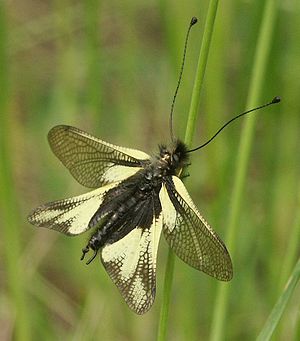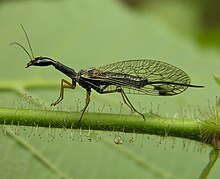Reticulated winged
| Reticulated winged | ||||||||||||
|---|---|---|---|---|---|---|---|---|---|---|---|---|

Dragonfly butterfly ( Libelloides coccajus ) |
||||||||||||
| Systematics | ||||||||||||
|
||||||||||||
| Scientific name | ||||||||||||
| Neuropteroid | ||||||||||||
| Orders | ||||||||||||
|
The Netzflügleriform (Neuropteroida or Neuropteroidea) are a group of the insects (Insecta). They include three orders, the camel neck flies (Raphidioptera), large-winged (Megaloptera) and reticulated winged (Neuroptera). Their taxonomic position is unclear. Some authors see the reticulated winged species as the order and the three associated taxa as subordinate orders, others refer to them as the superordinate order. Around 6500 species in 22 families are counted among the net-winged species occurring worldwide, with the net-winged making up the majority with around 5,500 species. They represent the most primitive holometabolic insects and are closely related to the beetles (Coleoptera) and fan-winged (Strepsiptera), which together form the sister taxon of the Coleopteroida .
features
Characteristics of the adults
The animals are very different in their appearance and vary in their wingspan from a few to 200 millimeters. The fore and hind wings are the same in most species in construction. The hind wings of the mud flies are usually larger and of the threadlike (Nemopteridae) they are drawn out to very long and narrow threads, which can be widened at the end. Some species have reduced wings, but there are very few that do not have any. Some day-trippers in Hawaii , such as B. Nesothauma haleakale have hardened forewings, which cover wings of the beetle are similar. The overwhelming number of species have transparent wings with a network-like veining of the wings, only in a few species the wings are brightly colored, mostly spotted. Only a few species have eye spots , such as B. Dendroleon pantherinus . Their mouthparts are biting-chewing and usually of simple construction. In some species, such as B. Acanthacorydalis or Corydalus but the mandibles are up to 30 millimeters long. Her compound eyes are large and sit hemispherically on the side of the head. In some Butterfly adhesion (Ascalaphidae) are transversely divided by a seam. Point eyes ( Ocelli ) are only present in the Raphidiidae , Corydalidae and almost all Osmylidae , they are absent in the other families. The antennae are many-sided, long and thread-shaped. In the butterfly-like and ant maiden (Myrmeleontidae) they are thickened at the end in a club-shaped manner, in the Chauliodinae they are combed in the males. The prothorax of the camel neck flies and the captive (Mantispidae) is greatly elongated, with the latter their fangs start directly behind the head, at the beginning of the prothorax. The first pair of legs of the Rhachiberothidae and several dusty ones (Coniopterygidae) are also formed into catch legs. The other species have normally formed insect legs , each of which attaches to the three thorax segments . The tarsi have five limbs and two claws at the end, the third one in the camel neck flies and the fourth one in the Sialidae is widened in a lobed manner. The abdomen has 10 segments, the latter of which are modified into genital apparatus. This can e.g. B. be clamp organs in males or long ovipositors in females.
Characteristics of the larvae

The larvae of the camel neck flies and the mud flies, like the adults, have simple, biting and chewing mouthparts. The netwings, on the other hand, have a suction organ made up of mandibles and maxillae , which consists of two channels. Most species also have a venom canal. The thorax is wide in most species, but there are also species such as B. Crocinae , in which this is very long and narrow. The legs are simply built, only the tarsi of the camel neck flies are divided into two parts. The abdomen is elongated to stocky. Seven or eight articulated tracheal gills can be seen on the abdomen of the larvae of the large winged birds and some Sisyridae that live in the water. But there are also aquatic species ( Nevrorthidae ) that have no gills. Many reticulated winged larvae , especially those of lacewings (Chrysopidae), have hooks on their abdomen, onto which they throw food scraps and other small parts with their heads to improve their camouflage.
Way of life
In the few days and weeks that their lives last, the adults feed on various arthropods , depending on the species , and sometimes also pollen or purely phytophagous pollen, fungi and algae. Among the predators there are those who lie in wait for prey , such as the captive, or those who capture their prey in flight, such as the butterfly-like. The Sialidae take practically no food, they only eat a little nectar.
The larvae of almost all species are predatory, and some also eat pollen. Among other things, they live on bark, on plants, in the ground, in sand or in water. There are also some species that live as parasitoids . By the time they are fully grown, they go through 10 to 15 larval stages, but netflies go through three to five larval stages. The ant lions build characteristic funnels in the sand, mainly to catch ants.
Mating and development
The partners are not only attracted by various pheromones that are emitted by scent glands on the thorax and abdomen, but also by vibrations that the animals transmit to the ground or leaves and the like. About the different frequencies that are sent out you can z. B. distinguish habitually very difficult to distinguish lacewing species. The eggs are either laid on leaves, in the ground or under the bark using the ovipositor. The eggs of larvae that later live in the water are laid on branches hanging over water so that the larvae can then drop. They are stored either individually or in large clusters of up to 3000 pieces. The captives also create community clutches that can contain up to 150,000 eggs. The eggs are elongated, curved or round and hang in some species individually or in bundles on long, very thin ice stalks. The development of the larvae takes very different lengths of time. In Europe, most species overwinter one to three times. With the exception of the Nevrorthidae, which pupate in a cocoon with two outer shells, pupation also takes place on land in the remaining larvae living in the water. The reticulated winged pupate in a web, camel neck flies and large winged pupates without such in small depressions.
Fossil evidence
The oldest known representatives of this order come from the Lower Permian ( large-winged as well as camel-necked flies and netflies ). In addition, netwings are known as larvae and adults from Cretaceous and Tertiary amber .
swell
- ^ FM Carpenter and L. Burnham: The geological record of insects . Ann. Rev. Earth Planet. Sci. 13, pp. 297-314, cited in Poinar 1992
- ↑ George O. Poinar, Jr .: Life in Amber . 350 pp., 147 figs., 10 plates, Stanford University Press, Stanford (Cal.) 1992. ISBN 0-8047-2001-0
- ↑ Wolfgang Weitschat and Wilfried Wichard: Atlas of plants and animals in Baltic amber , 256 p., Numerous. Fig., Pfeil-Verlag, Munich 1998. ISBN 3-931516-45-8
literature
- Ulrike and Horst Aspöck: camel necks, mud flies, ant lions ... Who are they? in camel necks, mud flies, ant lions. Neuropterida , Upper Austria Biology Center. Landesmuseums (Ed.), 1999, ISBN 3-85474-036-0
- Ekkehard Wachmann, Christoph Saure: Netzflügler, Mud and Camel Neck Flies , Naturbuch-Verlag, Augsburg 1997, ISBN 3-89440-222-9
